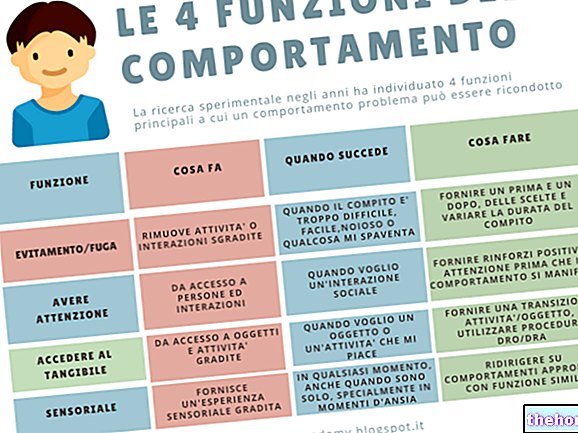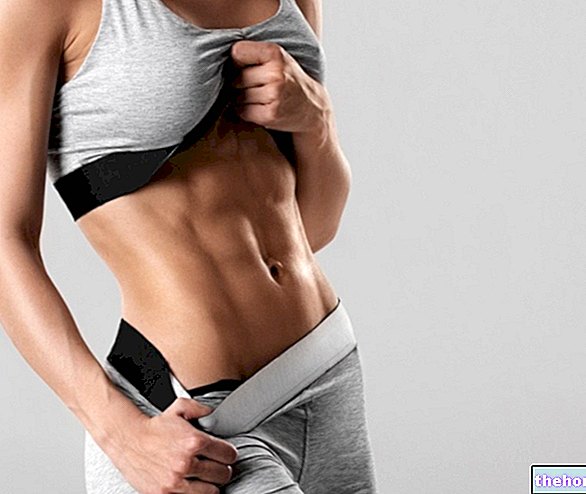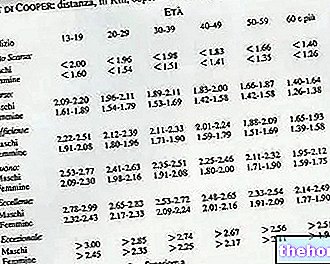For convenience of terms we will identify only the names of the most superficial muscles such as the dorsal gan, the trapezius and the rhomboids, and the biceps, in such a way as to schematize the programming in a very practical and fast way.

The reference test exercise here will be the pull-down on the lat-machine or, for fairly trained subjects, the pull-up. It should be borne in mind that about 5 sets of tests lasting 15-20 rep with 1-1.5 minutes of recovery between sets - so pull-ups are good to consider in really trained subjects.
Also in this case, the cases can be 6. According to the case of the burning induced by the Pull-down, the order of the sensations could be the following:
- Lats - Upper back - Biceps;
- Lats - Biceps - Upper back;
- Biceps-Dorsal-Upper back;
- Biceps - Upper back - Lats;
- Upper back-Lats-Biceps;
- Upper back-Biceps-Dorsals.
Also in this case for a statistical discourse most of the subjects identify the greater sensation of work as in case 3 in which the burning is mainly felt in the flexor muscles of the forearm, then in the dorsal muscles and, finally, in the upper part of the back.
Many will report that they also feel the work in the triceps and, in fact, especially the long head is pulled into play in the work chain of the traction movement; but it is good to take into consideration the work programming of the triceps with the bench-press test which is more specific for these muscles together with the pectoral muscles, deltoids (see first part of the article). In this case, one must try to abandon the sensation of the triceps and prioritize the burning sensation in the other affected muscles in the test.
The attention on the triceps often distracts from the sensations that are felt in the upper part of the dorsal or often in the deltoid (spinal portion) which, being all in the back of the shoulder, deceive. At this point I recommend proceeding further with other sets and try to identify with a good approximation which are the muscles, between the great dorsal and posterior deltoid, which give the greatest burning sensation.
Another problem that could arise is that of the gripping muscles of the hand; in fact, the muscles of the forearm can get tired early and in this case it may be useful to use the hooks, but for testing only. Often, these supports, if used routinely, can end up weakening the grip and forcing the subject to continual use to train in exercises that require an important grip such as pull-ups or rowing.
Often in the execution of pull-ups, many experience intense work in the abdominal part. If you observe a subject performing the pull-ups, you can notice that towards the last repetitions the latter will instinctively begin to practice a retroversion of the pelvis.
He will also flex the hip, and will try to find an anchor with the lower limbs to make a fixed point and also activate the hip flexor chain; and this is why it is very important, during the "execution of the pull-down (lat-machine)" to remove the cushions that block the knees ", precisely to avoid the marked activation of the anterior flexion chain, partially distorting the work of the drive chain.
It remains that, if the load is high, it is inevitable that the subject rises from the seat, but at this point it would be more appropriate to try the free pull-ups on the bar than the machine.
In the hip flexion chain the main involved is the ileo-psoas (as well as the rectus femur) which, let's not forget, is a powerful lordosing muscle and, if retracted, can lead to a series of problems. Therefore, unless its work is explicitly requested (such as in hypolordotics), it is always good to remove the leg cushions.
Note: always remember that the number of repetitions indicated and the relative work time for that series must be maximum, so when it is indicated, for example, the number of 15 repetitions and about 45 seconds of work it means that that load must allow the maximum no more than 15-16 repetitions for about 40-50 seconds. Training percentages could also be used, but the calculation would become too complicated for those who are not technicians or experts in the field. If you want to deal with the matter, it is good to remember that high loads should be used for white fibers around 85-90% of 1RM, for red fibers, loads around 60-65% of 1RM and for intermediate loads. around 75% of 1 RM.
(pull-down) 7-10 reps (about 15-20 seconds) with 2-3 minutes of recovery;If the goal is to try to increase the volume of the arms, you can also try to perform 2 sets of curls on the scott bench instead of 4 sets of just barbell curls. The position on this bench tends to bring the shoulder stump anteriorly, therefore, in the if the subject was already in this position due to a "postural defect", it is better not to rage with this exercise and perhaps concentrate on stretching the pectoral minor and the short head of the biceps and try to recover the flexibility of the shoulder.
It should also be added that this problem can aggravate the dorsal kyphosis, even only from an aesthetic point of view (without para- or dysmorphism) since the shoulders tend to close, even if perhaps the dorsal column respects a physiological kyphosis without accentuations .
Another consideration concerns the use of the barbell or dumbbells in the curl. If you perform a few repetitions with high loads as in cases 3 and 4 then it is recommended to perform this exercise with the barbell, having greater stability and the ability to recruit more motor units due to the fact to lift large loads in a single movement for a few seconds. In the case, however, of long repetitions then you may prefer the choice of dumbbells, trying to focus attention on the burning and accumulation of lactate in a more "concentrated" way. however, everyone agrees on this theory, given that in the alternating curl with dumbbells - especially in the hammer curl - it is possible to express much more strength than using the barbell, also thanks to the postural compensation of the stabilizers (core and deep back).
As for the sitting or standing position, it depends on the postural condition of the subject and the curves of the spine, remembering that in the sitting position the lumbar curve is canceled and the cervical curve increases, therefore the load on the spine is increased; ergo if the subject requests it then, he can sit on a bench, but otherwise it is preferable to remain standing and maintain physiological curves of the spine without bending the knees, as often happens, with the conviction of "unloading the back", to unless it is explicitly required by a condition of marked hyperlordosis.
If the subject falls into the 2nd case (Lats-Biceps-Upper back) the program should have an order more or less as follows:
- 3-5 sets of pull-up or lat machine (pull-down) 7-10 reps (about 15-20 seconds) with 2-3 minutes of recovery;
- 2 sets of low Pullay of 10-15 reps (30-45 sec) with 1 minute and 30 seconds of recovery;
- 3 sets of barbell curls of 10-15 reps (30-45 sec) with 1 minute and 30 seconds of recovery;
- 2 sets of Shrug with dumbbells of 15-20 reps (40-60 seconds) with 1-1 minute and 30 seconds of recovery;
- 2-3 sets of 90 ° lateral raises or 2-3 sets of Reverse Crosses on the cables of 20-25 reps (> 60 seconds) with 45 seconds of recovery.
If the subject falls into the 3rd case (Biceps-Dorsal-Upper back) the program should have an order more or less as follows:
- 2-3 sets of pull-up on the bar with supine grip (pull-up) or lat machine (pull-down) 7-10 reps (about 15-20 seconds) with 2-3 minutes of recovery;
- 2-3 sets of dumbbell rowing of 10-15 reps per arm (30-45 seconds per arm) with 1 minute and 30 seconds of recovery;
- 2 sets of jerseys of 10-15 reps (30-45 seconds) with 1 minute and 30 seconds of recovery;
- 3 shrug sets of 15-20 reps (40-60 seconds) with 1- 1 minute and 30 seconds recovery;
- 2-3 sets of 90 ° side raises or 2-3 sets of reverse crosses on cables of 20-25 reps (> 60 seconds) with 45 seconds of rest.
If the subject falls into the 4th case (Biceps-Upper back-Lats) the program should have an order more or less as follows:
- 3-5 sets of pull-up on the bar with supine grip (pull-up) or lat machine (pull-down) 7-10 reps (about 15-20 seconds) with 2-3 minutes of recovery;
- 2-3 sets of dumbbell rowing of 10-15 reps per arm (30-45 seconds per arm) with 1 minute and 30 seconds of recovery;
- 3 sets of 90 ° side raises or 3 sets of reverse crosses on the cables of 15-20 reps (40-60 seconds) with 1-1 minute and 30 seconds of recovery;
- 2 sets of pullovers of 20-25 reps (> 60 seconds) with 45 seconds of recovery.
If the subject falls within the 5th case (Upper back-Dorsal-Biceps) the program should have an order more or less as follows:
- 3-5 sets of dumbbell rowing 7-10 reps (about 15-20 seconds) with 2-3 minutes of recovery;
- 2-3 sets of pull-up or lat machine (pull-down) of 10-15 reps (30-45 seconds) with 1 minute and 30 seconds of recovery;
- 3 sets of jerseys of 15-20 reps (40-60 seconds) with 1-1 minute and 30 seconds recovery;
- 2-3 sets of 20-25 reps barbell curls (> 60 seconds) with 45 seconds recovery.
If the subject falls within the 6th case (Upper back-Biceps-Dorsals) the program should have an order more or less as follows:
- 3-5 sets of dumbbell rowing 7-10 reps (about 15-20 seconds) with 2-3 minutes of recovery;
- 2-3 sets of pull-up on the bar with supine grip (pull-up) or lat machine (pull-down) of 10-15 reps (30-45 seconds per arm) with 1 minute and 30 seconds of recovery;
- 3 sets of barbell curls of 10-15 reps (30-45 sec) with 1 minute and 30 seconds of recovery;
- 2-3 sets of pullovers of 20-25 reps (> 60 seconds) with 45 seconds of recovery.
Having almost reached the end of the third part of these three articles, we can understand how the combination of cases that are found after the test exercises can be really many. The creation of a program aimed at muscle growth can have several joints between the results obtained from the tests. Therefore it seems evident that having the possibility to perform certain tests, it is possible to develop sensible and above all specific programs for each tested subject.




























